El Banco de Morelos
The concession for this bank was granted on 17 September 1902 to S. Robert y Compañía, Meyran Donnadieu y Compañía, M. Bellon y Compañía Sucesores, Valeriano Salceda, Florencio Sánchez, José Díaz and Ignacio Robles, and the bank opened on 1 February 1903The Mexican Herald, 7 February 1903.
The local board of directors consisted of José Díaz, Ignacio Robles and Juan Posada, all prominent businessmen in Cuernavaca while the Mexico City board consisted of Emilio Meyran, Antonio Donnadieu, Fernando Pimentel y Fagoaga, Pedro S. de Azcue, Florencio Sanchez, E. Monjardín and Angel Alvarez, who held most of the stock representing the bank's $1,000,000 share capitalThe Mexican Herald, 7 February 1903: Periódico Oficial, 2 May 1903.
The main office was in Cuernavaca and the bank had permission to open a branch in Acapulco, in the neighbouring state of Guerrero. This branch was opened on 14 September 1903, and the bank assigned it 10,952 notes with a total value of $99,970(informe of interventor Martínez, 24 January 1904 in Memoria de las Instituciones del Crédito, 1903) In December 1906 the gerente, Federico Pintos, and cajero, Carlos Adame, resigned and Ricardo Velasco and Henoc Javarez were appointed in their place.. It also established branches in Cuautla, Morelos and Iguala, Guerrero.
American Bank Note Company print runs
In October 1902 the American Bank Note Company produced the following notes. The company engraved a special portrait of José María Morelos (C 259) for the $100 note.
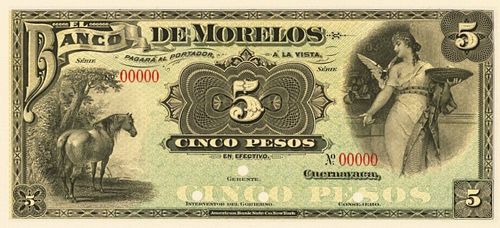
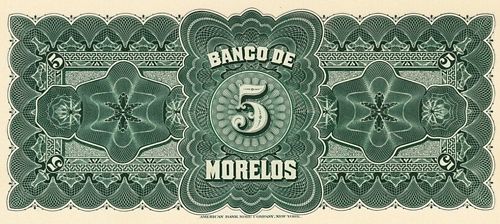 M417s $5 Banco de Morelos specimen
M417s $5 Banco de Morelos specimen
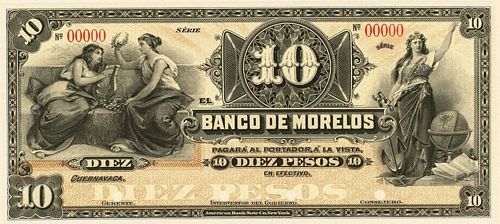
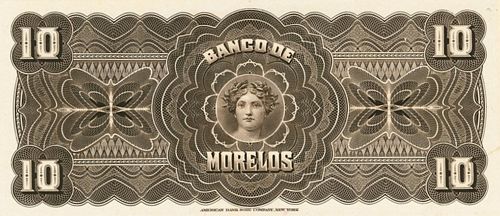 M418s $10 Banco de Morelos specimen
M418s $10 Banco de Morelos specimen
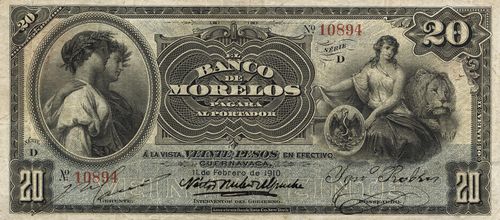 M419s $20 Banco de Morelos specimen
M419s $20 Banco de Morelos specimen
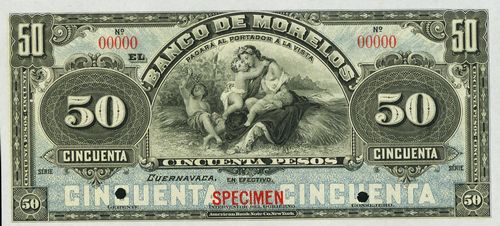
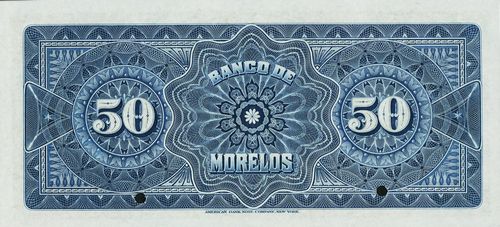 M420s $50 Banco de Morelos specimen
M420s $50 Banco de Morelos specimen
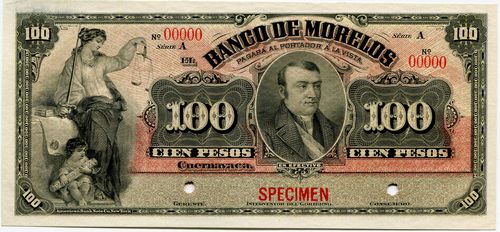
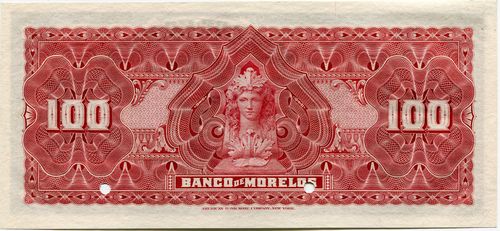 M421s $100 Banco de Morelos specimen
M421s $100 Banco de Morelos specimen
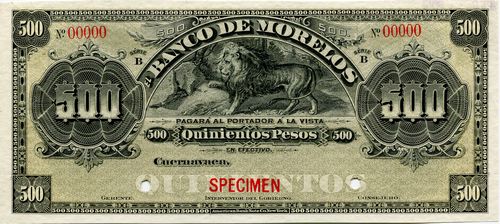
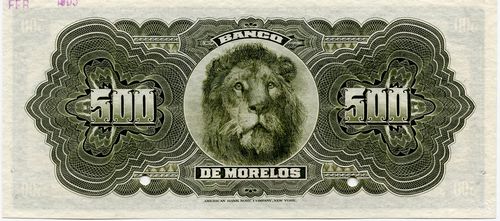 M422s $500 Banco de Morelos specimen
M422s $500 Banco de Morelos specimen
| Date | Value | Number | Series | from | to |
| October 1902 | $5 | 100,000 | A | 1 | 50000 |
| C | 50001 | 100000 | |||
| $10 | 60,000 | A | 1 | 30000 | |
| E | 30001 | 60000 | |||
| $20 | 15,000 | A | 1 | 7500 | |
| D | 7501 | 15000 | |||
| $50 |
6,000 | A | 1 | 3000 | |
| F | 3001 | 6000 | |||
| $100 |
2,000 | A | 1 | 1000 | |
| G | 1001 | 2000 | |||
| $500 | 200 | A | 1 | 100 | |
| B | 101 | 200 |
Signatures
The (identifiable) signatures are Emilio Bersinger, Juan N. Carreón and J. Zorrilla as Gerente, lgnacio Robles, Marcelino Velázquez, José Díaz and Fernando Güernes as Consejero, and Néstor Rubio Alpuche and Ventura Martínez del Río as Interventor.
Gerente
|
Emilio Bersinger was formerly a director of the Banco Internacional é Hipotecario de MéxicoThe Mexican Herald, 7 February 1903. From January 1910 to August 1912 he was subgerente of the Compañía Bancaria de Paris y México, S. A. He signed notes dated 1903 and 1904. |
 |
|
Juan Nepomuceno Carreón was originally from Chihuahua, and became manager in 1905. Surprisingly, on 2 June 1911 he accepted the post of provisional governor of Morelos from Zapata as he had sympathised with the revolution as a patriotic duty ARD, 4, 17, 63 letter Carreón to Robles Domingúez, 31 May 1911. He signed notes dated 1910. |
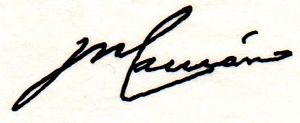 |
Consejero
|
José Díaz He signed notes throughout the history of the bank, from 1903 to 1910. |
 |
|
lgnacio Robles He signed notes dated from 1903 to 1910. |
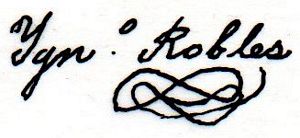 |
|
Juan Posada He signed notes dated 1903. |
 |
|
Marcelino Velázquez He signed notes dated from 1904 to 1910. He died in Mixcoac, Federal District, on 7 May 1911, while still serving as a consejero of the bankSemanario Oficial, XXI, Núm. 19, 11 May 1912. |
 |
Interventor
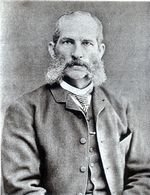
José Ventura Martínez del Río y Pedemonte was born in 1866, a member of one of the most prominent families in Mexico. In May 1898 he received a federal concesión to construct a tramline from Ciudad Lerdo to Torreón, passing through Gómez PalacioEl Tiempo, 28 May 1898. He was the bank's first InterventorEl Popular, Año VII, Núm. 2244, 26 March 1903. He married Rosa Bermejillo Martínez-Negrete. After suffering for several weeks from serious stomach trouble he died on 18 December 1906 from heart failure at his home at 3a calle de las Fuentes Brotantes, no. 1629The Mexican Herald, 19 December 1906. |
  |
|
R. Martínez Freg took over as interventor on 22 September 1903informe of interventor, 24 January 1904 in Memoria de las Instituciones del Crédito, 1903 |
 |
|
He signed notes dated 1910. |
 |
In 1915 the bank did not produce the necessary documentation to the Comisión Reguladora e Inspectora de Instituciones de Crédito so Rafael Torres was instructed to investigate the offices in Mexico City. He reported that Juan N. Carreón had told him that their records were in Cuernavaca but as soon as it was possible to compile the information and hear from their branches in Iguala and Acapulco they would produce a balance sheet. The same day Carreón asked the Secretaría de Hacienda for an extension. The Comision felt that circular núm. 46 categorically declared that any bank that had not produced its documentation by the due date would have its concession cancelled, and on 12 January 1916 so decided.
In a report to Congress on 1 September 1917 Carranza said that in accordance with the reglamento of 8 March 1916 $94,130 in notes of the Banco de Morelos had been incineratedPeriódico Oficial, Tamaulipas, Tomo XLII, Núm. 75, 19 September 1917.
Under Obregón decree of 31 January 1921 the bank was placed into Class B (for banks whose assets and liabilities were about equal and which were given a short time in which to obtain the necessary funds to resume) and allowed to resume all customary operations except the issue of bank notes.
The bank was finally liquidated in 1930. On 9 July 1931 ABNC’s Resident Agent in Mexico City, Charles T. Blackmore wrote that he had written to the Banco Nacional de Crédito Agrícola, S. A.for authorization to destroy the plates used to produce the bank's notesABNC.

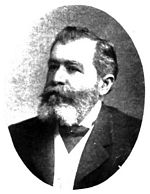 Néstor Rubio Alpuche was appointed interventor in late May 1905
Néstor Rubio Alpuche was appointed interventor in late May 1905